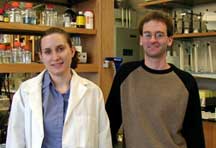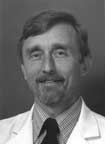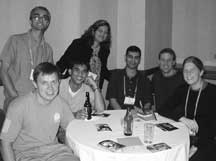
|
 |
Return to Table of Contents
News Briefs
MBL Welcomes First Students in the Brown-MBL Graduate Program in Biological and Environmental Science
 |
|
Justin Widener and April Shiflett
|
“Science is people,” says Dr. Stephen Hajduk, head of the MBL’s Global Infectious Disease (GID) Laboratory. “We need to be bringing in the best people.” Two of the people at a bench in Hajduk’s lab, Justin Widener and April Shiflett, are great examples of how the MBL is already making strides in this direction. Widener and Shiflett are the first students to enroll in the Brown-MBL Graduate Program in Biological and Environmental Science, a program recently established under the MBL’s strategic plan to extend its educational programs for graduate students beyond the summer courses.
If enthusiasm is any indication, Widener and Shiflett are proof that the
 |
|
Steve Hajduk
|
plan is working. Both students transferred to Brown University to follow Hajduk to the MBL when he left a tenured position at University of Alabama at Birmingham Medical School in early 2003. Even during an icy Cape-Cod winter, where temperatures hover well below freezing, Widener and Shiflett emit warm feelings about Brown, the MBL, Hajduk, and living and working in Woods Hole.
Shiflett, a third-year graduate student, says the transition to Brown and the MBL has been a smooth one. “It was a great opportunity to go to a school like Brown,” she says, “and logistically it will be much easier.” She also says she has learned a great deal from working in Hajduk’s lab. “He and I have figured out how to focus, plan, and carry out a scientific project,” says Shiflett. “What’s great about him is that he tailors the work to meet the needs of each student.”
Widener, now in his second year, says Hajduk’s open approach to communication and the structure of the GID lab—which is staffed by post docs, researchers, and, in the summer, local high school students—is what sets it apart from other labs. “You sometimes hear stories about how labs are boring places,” says Widener, “but that’s not the Hajduk lab. The integration of the lab helps with the flow of ideas.”
Widener and Shiflett, who work across the bench from each other on the third floor of Lillie, are focused on different aspects of Hajduk’s study of trypanosomes, tiny ribbon-shaped parasites that cause African sleeping sickness. The students, who often help each other solve research problems, have much more in common than the workspace they share. When seeking a graduate program, both students enrolled at University of Alabama expressly to work with Hajduk. And now that they are in the Brown-MBL program, they participate in a journal club together and make regular trips to Brown University to hear lectures and interact with students working in similar disciplines.
By the time they earn their Ph.D.s, Widener and Shiflett will have paid their dues on the lab bench, developed good research skills, taken courses at Brown, and published their findings in “at least three” papers, a process that generally takes four to six years. “Grad students generally produce publishable data in their last two years of work,” says Hajduk. “They are overly optimistic about what they can accomplish. They are learning the difficulties of science and discovery,”
he says.
To help students like Widener and Shiflett through the tough spots, Hajduk has structured his lab so everyone can help each other. “It’s important to have a range of students and post docs with different levels of experience,” he says. “And everyone needs patience and willingness to teach.”
Hajduk speaks from experience. To date, he has graduated “22 or 23” Ph.D.s, and mentoring up-and-coming scientists is one of his trademarks. In fact, he credits the Brown-MBL program for helping to lure him to the MBL. “I couldn’t have come without a mechanism for students,” he says.
So far, Brown seems to be the ideal partner. “I don’t think there could’ve been a better partner if you went down the list of eligible schools,” says Hajduk. “Brown is clearly a quality institution with a good academic reputation.”
Brown appears equally enthusiastic. Widener and Shiflett say the Pathobiology Department there has been “extremely welcoming.” And Hajduk has felt a strong camaraderie with faculty and researchers. “We’ve been fully encouraged to participate in course training and graduate student training,” he says. “And a lot of us have noticed that there have been many more opportunities as far as research and writing grants together.”
In fact, Hajduk recently co-wrote and submitted a Gates Foundation proposal with Dr. Susan Gerbi, chair of Brown’s Biochemistry Department and director of the Graduate Program in Cell and Molecular Biology. This semester he will give guest lectures in two different Brown science courses. And he is currently working to develop joint training programs he hopes will attract funding from the National Institutes of Health and the National Science Foundation.
The Brown-MBL Graduate Program offers other institutional benefits as well. “Historically the MBL has been focused on post docs, who are seeking more long-term stability,” says Hajduk. “Grad students—who generally turn over every four years or so—create a more dynamic environment that will expand MBL’s scientific contacts. The institution is strengthened by the [Ph.D.] who leaves and becomes a faculty member at a college or university. It lends stature to our institution,” he says.
Hajduk also predicts that grad students may someday change the face of the MBL. “If the program attracts six or so students a year,” he says, “it will become a considerably younger population than we have now. And as the students interact with faculty and others, the mere presence of the students will change the overall flavor of the institution.”
For their part, Widener and Shiflett are just beginning to see how doing graduate work at the MBL is affecting them. “I’m happy with it,” says Widener. “I wish it were going faster but you can only take in so much. And in this lab everyone is willing to help and that’s helped me get to where I want to be.”
“This has been the best year so far in my graduate career,” says Shiflett. “Everything changed. I’m in a totally different environment. I’ve been able to meet so many people in the field. It could be overwhelming for me but it’s been so charged, so exciting. It’s been outstanding.”
 |
|
William Beers
|
MBL Hires its First Chief Academic and Scientific Officer
Following the recommendations of the recently completed Strategic Plan, the MBL has hired William H. Beers as its first Chief Academic and Scientific Officer.
Beers will be responsible for leadership, planning, and oversight of all academic programs, equivalent to a Provost in a university setting. He will develop and oversee policies relating to scientific research and commercial relations with private enterprise, including intellectual property and technology transfer. Beers will also advise and work closely with the MBL Director and CEO William T. Speck and participate in the development of strategic direction of the Laboratory.
“The MBL is pleased to welcome Bill to the MBL community,” said Speck. “His successful record in scientific research and education administration, combined with his leadership abilities and experience in strategic planning, make him a valuable addition to our staff. We look forward to his arrival this spring.”
Beers has over 25 years of experience working with Boards of Trustees, CEOs, senior administrative staff, and faculty of non-profit research institutions. Beers received an A.B. in Biochemical Sciences from Harvard, completed his doctorate in Biochemistry and Pharmacology at The Rockefeller University, and held a postdoctoral fellowship at the University of Illinois before serving as an Associate and Assistant Professor of Cell Biology at The Rockefeller University from 1973 to 1978.
He joined the faculty of New York University in 1978, where he served as a Professor in the Departments of Biology and Cell Biology, as well as Biology Department Chair and
Director of Undergraduate Studies.
From 1991 to 2000, Beers held various positions at The Scripps Research Institute in La Jolla, California. There he oversaw all scientific departments and support services, and acted as a key player in the articulation and implementation of the Institute’s vision and mission.
Beers served as Vice President of Facilities and Research Support at The Rockefeller University from 2000 to 2002 where he was responsible for all facilities and research support departments, including plant operations, computing services, animal resources, and the library.
Since 2002, Beers has been Vice President of Operations and a member of the Board of Trustees of The Torrey Pines Institute for Molecular Studies in San Diego. He is responsible for all operational activities of the Institute, including faculty facilities, services, and instrumentation needs. Beers also plays an integral role in advising the President in strategic decisions for the Institute.
Beers conducted research in the area of female reproduction and is the author of numerous publications in leading scientific journals. He has served as a Trustee of several institutions and currently serves on the Boards of SciTekMedia, Inc., the Foundation for Biomedical Research, and the Torrey Pines Institute for Molecular Studies.
 |
|
Thomas Pollard
|
Annual Giving a Key Resource for the MBL
In 2003 the MBL Annual and Alumni Funds raised $612,047, surpassing the goal of $600,000, thanks to many donors who responded to the Trustees Challenge, thus doubling the value of their gifts, and to several long-time donors who increased their gifts substantially.
“The funds were used throughout the year to meet the diverse needs of scientists and students, and provided critical resources that enabled us to begin the planning for the renovation of the Whitman building,” said Annual Giving Chairman, Peter Armstrong. “I thank Michael Fenlon and Ruth Ann Laster, who led the Annual Fund drive for the MBL Associates, and all those who stretched to make this a terrific year.”
MBL Annual and
Alumni Fund Gift Clubs
The Century Club ($100-$249)
The Sponsor Club ($250-$499)
The 1888 Club ($500-$999)
The Whitman Society:
Member ($1,000-$2,499)
Patron ($2,500-$4,999)
Benefactor ($5,000-$9,999)
Director’s Circle ($10,000+)
Annual Fund or Alumni Fund gifts may be made through cash, Visa, Mastercard, Discover, or gifts of stock. Click for online giving or contact Kate Shaw, 7 MBL Street, Woods Hole, MA 02543; (508) 289-7416; kshaw@mbl.edu.
|
Dr. Armstrong, an MBL summer investigator, alumnus and member of the Science Council who has served as Annual Fund Chairman since 2001, has overseen one of the greatest increases in annual giving dollars in the past ten years, second only to the amount gained during the economic boom of the late 1990s. His term up, he will be stepping down as Chairman and handing the baton to Dr. Thomas D. Pollard.
Dr. Pollard is the Eugene Higgins Professor of Molecular, Cellular and Developmental Biology at Yale University. His lab focuses in two areas important for understanding critical cellular, developmental and disease processes: the molecular mechanisms of actin-based cellular movements, and the process of cytokenesis. Dr. Pollard is a member of the National Academy of Sciences as well as many scientific organizations. He is a member of the MBL Corporation, a former Director of the MBL Physiology course, a past Trustee and, most recently, a member of the Strategic Planning Committee.
 |
|
Members of the Neurobiology class
of 2000 get reacquainted
|
MBL Alumni Gather at Annual Society for Neuroscience Meeting
For the sixth year in a row, MBL hosted a gathering of alumni at the annual meeting of the Society for Neuroscience which was held in November 2003. The annual event is a chance for former students to catch up with classmates and faculty and to learn about research opportunities at the Lab. David Bodznick, summer investigator, former faculty member, former Grass Fellow, and now, head of the newly established Neuroscience Institute, spoke about this new initiative designed to recognize and promote the growth of neuroscience training and research at the MBL.
In Memoriam
Teru Hayashi
1914-2003
Dr. Teru Hayashi of Woods Hole, known by his many friends as Tay, died December 18, 2003, at the Royal Nursing Center in Falmouth from the effects of esophageal cancer. He was just eight weeks shy of his 90th birthday.
Dr. Hayashi taught graduate, undergraduate, and adult education students and was a popular and stimulating teacher of biology. Many of his students later became academicians and professors at universities such as Yale, Dartmouth, Berkeley, SUNY at Stony Brook, and Albert Einstein.
Born in 1914, Dr. Hayashi grew up in Atlantic City, where, after graduating from high school, he worked variously as croupier in gambling houses and for a circus act on the Steel Pier. He graduated in 1938 with a degree in physics from Ursinus College in Pennsylvania, and received his Ph.D. in biology from the University of Missouri in 1943. In 1945 he joined the biology department at Columbia University, rising to full professor and chairman of the department. Dr. Hayashi moved on to the Illinois Institute of Technology in 1967 to found and chair its biology department. He retired in 1979 as Senior Research Scientist at the Papanicolaou Research Institute, and subsequently Professor Emeritus in 1982. Dr. Hayashi’s research focused on the molecular basis of muscle contraction.
He was a member of the Society of General Physiologists, American Association for the Advancement of Science, Biophysical Society and Physiological Society. In 1954-1955 he was a Guggenheim Fellow and Fulbright Scholar in Denmark, and in 1974-1975 a Humboldt Fellow and Fulbright Scholar in Germany, and a Japan Society Visiting Professor in Japan.
Dr. Hayashi’s summertime association with the Marine Biological Laboratory dates from 1939, first as a student, and from 1948 on as an independent investigator. He was later elected an MBL Corporation Member and Trustee and was Trustee Emeritus at the time of his death. The MBL established the Tay Hayashi Lecture in Cell Physiology in 2002 to celebrate and honor Tay’s lifelong achievement, precious freedom, and indomitable spirit. The third annual Hayashi Lecture will be held this summer.
Dr. Hayashi was son of the late Andrew Tetsuji; brother to the late Akira, half-brother to Mitsuru, Osamu and Makoto Hill; husband of the late Sally Rexon and subsequently Sally Browne; father of sons Curt of Lexington, Massachusetts, Tomi of Bedford, Massachusetts, Tuck of Woods Hole, and daughter Tesa Brown of Sandpoint, Idaho; uncle of seven; and grandfather of three.
A memorial service will be held in Woods Hole this summer.
|